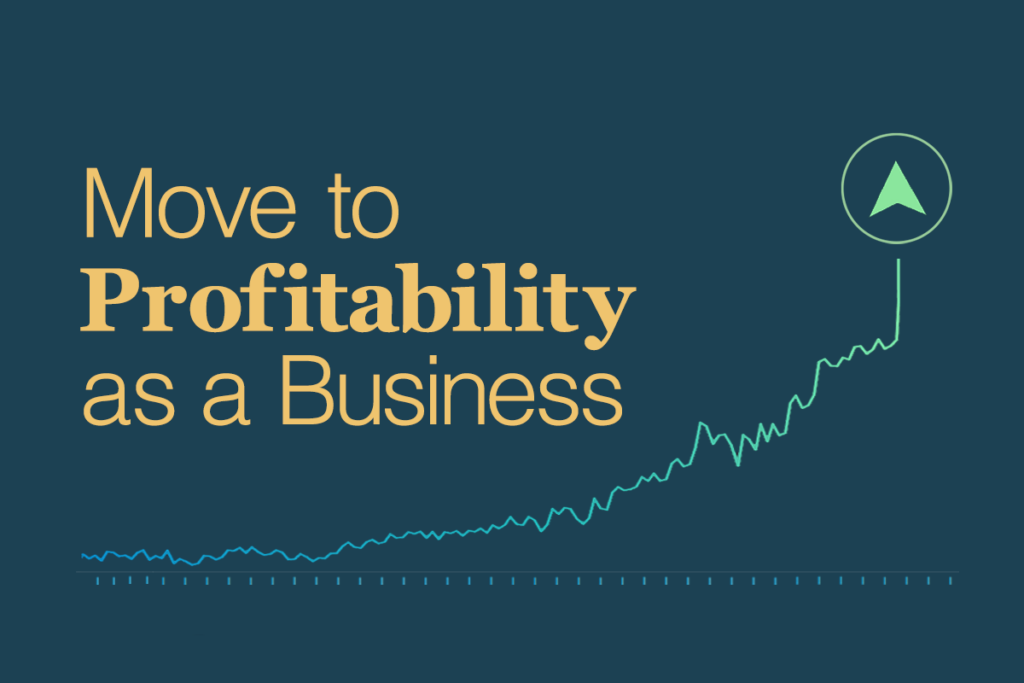
Brian Raphael
Chief Financial Officer & Technology Practice Area Lead
January 3, 2024
The New Startup Balancing Act: 5 Strategies to Move to Profitability
Startups looking to raise capital in 2024 face considerable headwinds, as investors slow their pace of investment and take more time to evaluate opportunities. Your startup should shift its approach and priorities accordingly, undertaking a growth/profitability balancing act that considers your stage, unit economics, working capital management, burn rate, and more.
Investor expectations have changed. Over the course of several years, cheap capital combined with a herd mentality have caused both companies and investors to value growth over profitability. Investors saw cash-constrained startups as the norm, engendering a “growth at any cost” philosophy that downgraded risks and increased valuations. Now, “sustainable growth” is the golden ticket, with investors expecting startups to balance high growth with a focus on capital efficiency and a viable path to profitability. Startups looking to move to profitability must take strategic risks – cutting in one area while investing in another, regularly revisiting what’s working and what isn’t, and shifting strategies at each stage.
1. Consider Your Stage And Build Accordingly
Not every startup can or should be profitable. Your startup’s approach will change based on your stage, priorities, strategy, cash position, and access to additional capital. For example:
- At Seed and Series A, it’s almost impossible to be profitable unless you’re a professional services business. When starting from zero, you generally need to invest in building momentum (e.g., product, brand awareness).
- The interval between Series A and B often consumes the most capital. At this stage, you’re driving growth to beat out the competition and build your customer base, while at the same time optimizing your product to make it more competitive.
- Between Series B and C, however, you can often throttle back on spending, achieving profitability at your discretion. The goal is striking the right balance between turning a profit, managing cash flow, and reinvesting in your business.
2. Review And Optimize Your Unit Economics
Unit economics shows how profitable you are by analyzing your cost-to-revenue ratio relative to your “unit” — that is, the quantifiable individual element (e.g., one customer, one item sold) that your business uses to measure value. Accordingly, unit economics helps you forecast how quickly your startup can achieve profitability. It also gives you a clearer picture of your business processes and how they impact financial performance, positioning you to evaluate your product’s potential (e.g., sustainability, profitability) and identify opportunities to optimize it.
Over the past year, we’ve seen many investors asking for true unit economic analysis as part of due diligence. This wasn’t part of most diligence packages historically. Make sure you can speak knowledgeably about the individual components of your unit economics and how they can be improved (i.e., which levers can be pulled). Begin by identifying the right metrics for your business and doing the math to determine both actual and predictive unit economics. Then, uncover tactics to improve unit economics with levers such as:
- Increase Pricing. Small pricing changes can have a big impact. We too often hear from new clients that they haven’t adjusted pricing in years — even as suppliers drastically increase costs. Reevaluate pricing every six months to ensure it aligns with what the market can accept and keeps pace with inflationary pressures, commodity price changes, and other costs. Consider testing new pricing strategies.
- Lower Cost of Goods Sold (COGS). Explore creating efficiencies by collaborating with (or changing) suppliers and vendors, modifying formulation or packaging, reducing waste, offering incentives, building strategic relationships, or undertaking more long-range planning (e.g., volume increases/discounts, shipping speed, warehousing costs/location).
- Understand Customer Acquisition Cost (CAC). CAC tracks how much you spend to acquire one customer, and the LTV/CAC ratio shows how much you expect to earn from each customer over their total lifetime (lifetime value, or LTV) relative to how much you spent to acquire that customer (CAC). It’s critical to strike the right balance with CAC – not spending too much, and not spending too little. While spending too little may mean missing out on or jeopardizing customer relationships, spending too much jeopardizes profitability. To optimize CAC, consider streamlining sales and marketing processes (e.g., analytics, subscriptions, CRM strategy), shifting sales channels and markets, using customer feedback to align strategy, and exploring strategic partnerships (e.g., e-commerce businesses partnering via fee-based relationships to drive new traffic and sell each other’s products).
- Put Guardrails on Overhead. It’s critical to periodically reevaluate and reset how much overhead you have relative to revenue and growth expectations. That may mean layoffs, which are understandably difficult for many founders. The reality is that changing growth and revenue expectations should equate to changing overhead.
All of these areas of your business will evolve over time. What makes sense at Series A probably won’t hold at Series C. So it’s important to periodically reevaluate, taking a fresh look at each stage.
3. Look To The Balance Sheet To Improve Working Capital Management
Moving toward profitability requires effective management of working capital. Many early-stage businesses overlook how the balance sheet can be used to calculate metrics and find opportunities to improve working capital. For example:
- A/R days sales outstanding. This metric measures the average number of days it takes your business to get paid. Are your A/R billing practices good for cash flow? Consider terms that help you get paid more quickly, such as charging upfront, requiring down payments, or accepting credit cards instead of invoicing customers on terms. This can be especially effective for service-based businesses that bill clients monthly.
- A/P days payables outstanding. This metric measures the average number of days it takes your business to pay its bills and invoices. How well are your payment practices managing your outflow of cash to increase working capital? Consider negotiating terms with vendors – especially if you have inventory. For example, if the supplier typically offers net 30, try negotiating for net 60 or net 90 – giving you more time to pay your bills, thereby freeing up capital.
- Inventory. Alongside A/R and A/P, inventory management is probably one of the top three working capital levers your business has available. Make sure procurement and management processes are capital-efficient so that materials arrive no earlier than needed and you avoid building up inventory you don’t need. For example, reducing inventory days from 60 to 45 at a $1M/month company can free up $250K in cash. Also, review inventory demand planning opportunities. While supply chains continue to ebb and flow, we are seeing some calming, enabling more long-range planning. Can you afford increased product runs to get volume discounts? Factories may be eager to lock up runs early.
- Capital expenditures, or CapEx, are the funds your company uses to pay for acquiring, upgrading, and maintaining longer-term physical or fixed assets used in operations (e.g., land, buildings, furniture, computers/software, manufacturing equipment, vehicles, patents). Importantly, CapEx is tracked on the balance sheet as an investment (as opposed to on the income statement as an expenditure), making it an asset.
- Financing. With traditional equity fundraising more uncertain, startups can increase working capital through alternative financing such as:
- Inventory financing. Many startups don’t realize that their inventory is an asset they can use as collateral to secure a line of credit or short-term loan. Inventory financing is a form of asset-based lending that may be appropriate for many businesses.
- Asset-backed loan (ABL). Facilities can be an effective financing option, since your startup’s assets — everything from brand names and IP to inventory, real estate, and accounts receivable — become your collateral.
- Factoring. Accounts receivable factoring is a short-term debt financing solution that allows businesses that sell on credit terms to sell or assign their discounted accounts receivable to a third party for immediate cash.
- Alternative debt financing. Alternative lenders such as Clearbanc and Shopify stepped up during the pandemic to offer financing to e-commerce businesses. Instead of charging interest or taking equity, these loans charge fixed fees atop financing and take cuts of sales/revenues until financing is paid back.
- Credit cards. Consider getting existing limits increased or exploring alternatives like Brex, a fintech offering early-stage startups subscription- and fee-based corporate credit cards and bank accounts.
- Bridge notes. Investors may use bridge rounds to give startups extra funds between larger funding rounds. Consider talking to existing investors to explore whether bridge notes are an option.
- Capital efficiency. Capital efficiency measures how efficiently your business uses its resources to operate and grow. How much are you spending to generate how much revenue? It’s critical for startups to achieve a balance, which may require decreasing growth to increase capital efficiency. Evaluate the capital efficiency of your channels and shift efforts accordingly (e.g., wholesale channels tend to require more inventory and A/R than D2C channels).
4. Cut Burn By Strategically Cutting Expenses
Today’s investors expect your startup to spend less to get where you need to go. Your burn rate measures how quickly you’re spending your capital, making it a crucial metric for understanding and tracking your financial health, extending your runway, and more. Managing burn – either by reducing expenses, or keeping them low in the first place – gives your startup more flexibility and more options.
Cutting burn involves taking calculated, thoughtful risks, which requires learning to use metrics and financial data to guide decision-making. For many founders, it’s the first time they’re learning to look at their organization as a full-fledged business instead of just a product. It’s critical to avoid the common pitfall of cutting “just to cut.” If cuts don’t happen as part of a well-thought-out strategy, the cutting signals to everyone around you that you don’t understand what really matters to your business model. Weigh your opportunities to cut burn in:
- Headcount. For many companies, cutting headcount is the primary method they can use to cut burn. Are there opportunities to reduce payroll costs by cutting non-essential headcount or deferring planned hires? Make sure cuts are appropriate and sustainable.
- Sales and Marketing. Are any channels proving unprofitable? You may want to consider shifting channels, or putting initiatives on hold in favor of a later relaunch.
- OpEx. What discretionary expenses (e.g., subscriptions, dues, advertising/marketing) aren’t contributing to the success of the business?
- CapEx. Can you delay major purchases of buildings or equipment, or rent instead of buying?
As you consider your options, it’s helpful to weigh any upfront costs alongside the amount of time it will take for savings to materialize. For example:
- Reductions in discretionary items such as T&E and lower- or long-term ROI marketing spending can have an immediate impact.
- Reductions in employee-related costs can take a bit more time to have an impact, and there may be some upfront costs associated with severance and PTO. Savings achieved through a reduction of hours, however, can materialize more quickly.
- Renegotiating or canceling lease obligations typically takes time — and in the latter case, likely requires some upfront costs.
- Strategic initiatives such as cutting less profitable product lines or distribution channels often require more time for planning and working through implications.
Bottom line, it’s critical to stay cognizant of how and where you’re spending money and making key investments. Make sure you’re regularly reviewing your financial statements. Where spending doesn’t result in positive ROI, saying “no” is a reasonable answer.
5. Prioritize Customer Retention And Wallet Share Over New Customers
Moving toward profitability and sustainable growth requires focusing on the right priorities. In the context of customers, that generally means prioritizing existing customers over new ones. The reality is that selling more to customers you already have is a more capital-efficient strategy than trying to acquire new customers. According to 2022 McKinsey research, successful companies are finding ways to become indispensable to their customers – but in many cases, are finding it increasingly difficult: CAC rose an average of 60% since 2017, reflecting a disconnect between what customers care about and what companies think they care about.
Regardless, getting a higher percentage of your revenues from existing customers is the No. 1 lever you can move to become more capital-efficient. That means building real relationships with your customers, as well as developing thoughtful strategies around customer success – something many founders don’t think about until it becomes a problem. Many companies need help learning how and when to reach out to customers to create opportunities to increase customer retention and wallet share.
Prioritize A Capital-Efficient Playbook With The Right Guidance
Balancing growth against profitability is a central challenge for every startup. The key is developing the right plan to fit your stage, optimizing processes accordingly, tracking the metrics that matter, and revisiting them regularly to assess whether changes are needed. It’s also valuable to find a financial partner who has seen similar companies through the same types of challenges. Pattern matching can be extremely powerful in the right hands. It’s one of the many ways Propeller Industries helps startups across industries navigate the complexities of growth with more strategic, capital-efficient playbooks.
While the transition to a new set of investor expectations is causing pain for companies raised on a now outdated playbook, this is a healthy correction for the entire VC ecosystem. This shift should ultimately put founders – as well as other common stockholder employees – in a much better position to see upsides in their equity.
Ready to make sure your startup is empowered to move toward a more sustainable and profitable future? Reach out today to start a conversation with one of our experts.



